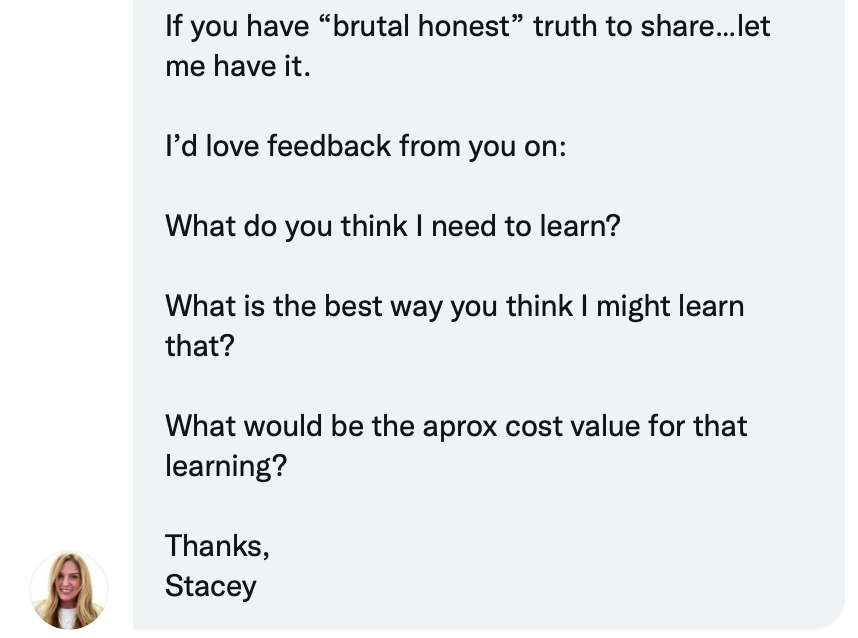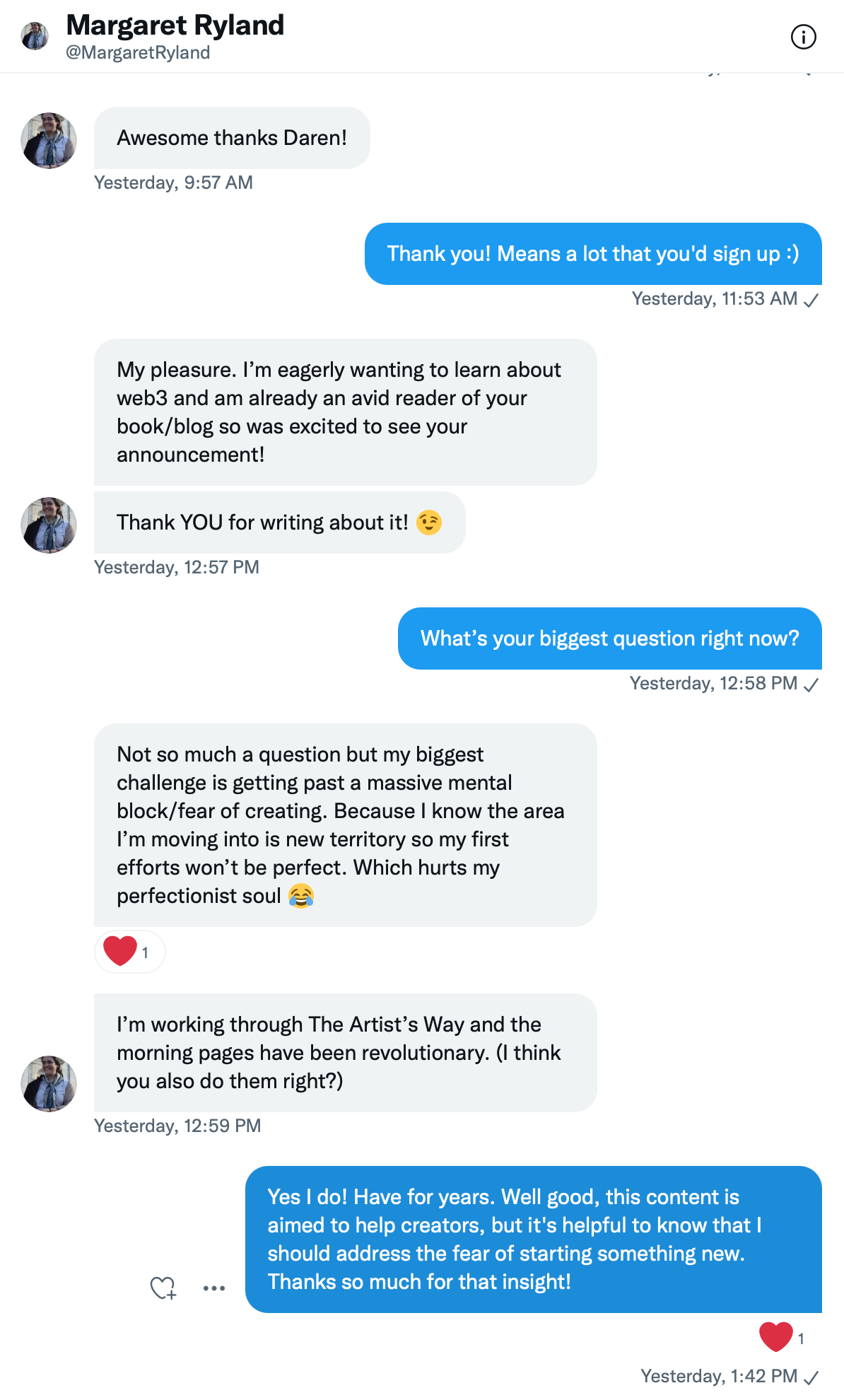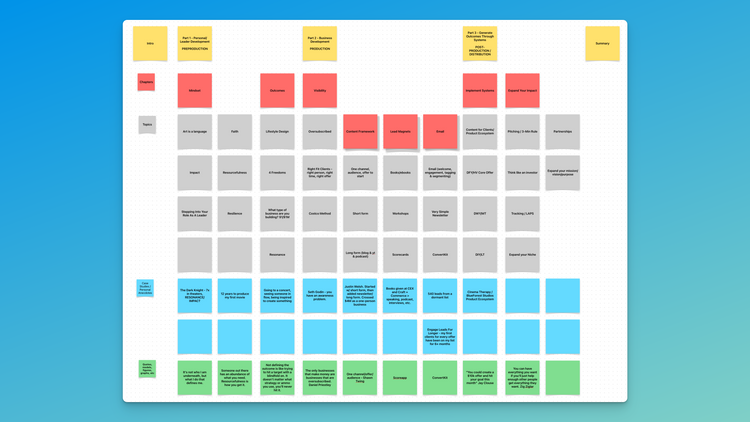Create Products Based On Your Audience's Needs

You've identified the "jobs to be done" for an audience you seek to serve, and you've started building in public to show that you're capable of doing those jobs.
Now what?
To start or grow a business from here is a process of listening and observation and analysis, and in this chapter, I'll show you the signals to look for that reveal the products you can create to best serve your audience's needs.
The Signals To Listen For
It wasn't until I started taking this all seriously that I started to see these signals, but when they started to show up it was clear that I was on to something.
Whether you write a newsletter, post on social media, or are simply building in public and sharing your work, you'll start to see signals that show you that you're doing things right.
For years I struggled to grow an audience and write consistently. It wasn't until 2021 that I decided to grow both my email list through my newsletter and free content and my Twitter following to get more awareness.
The reason I chose those two channels is that it's become clear in the last year how much easier it is to have a successful career as a creator if you have a minimum viable audience.
When I realized this, I did not have a minimum viable audience. I had nearly 1,000 followers on Twitter, but those had accumulated over the 12 years that I'd been on the platform, and my guess is that most of those followers were either bots or inactive or both.
My email list was in a similar state. I had grown it to about 1,000 subscribers, but that was a combination of people that came to events, people who signed up for email series in the past, and those that were interested in what I was writing now.
I maybe had 400-500 people that were actively reading.
Here's how I knew I did not have a minimum viable audience:
In 2020 I started craftsmancreative.co, an online course platform for creators. I began with two of my own courses, and proceeded to tell my audience, "hey! I made this thing for you that I know is valuable and I know you'll like!"
Except, they didn't find it valuable, nor did they like it.
I managed to sell less than 10 people on those courses during the launch. Half of those were "pay what you want" pricing at 50-80% off.
The audience was too minimal to be viable.
So, what are the signals that you're looking for:
People that are subscribed engage with your content
You can measure this as a ratio or a percentage, but ideally, you want to be at 50% or more.
Meaning, if you have 100,000 YouTube subscribers, you can count on 50,000 or more of them viewing your videos every week.
If you have a 1,000 person email list, you have a 50% open rate (which is changing because of how Apple is allowing emailing tracking on their phones and computers, but you get the idea).
If you have 5,000 followers on social media, you want to see 2,500+ impressions every time you post new content.
Your audience is reaching out to you directly with questions
This just started happening to me this year when I took my newsletter and Twitter more seriously. I made it easy for people to reply to the emails and left my DMs (direct messages) open on Twitter so that anyone could message me, not just the people I follow.
Every day I get new people messaging me that I've never met or interacted with before. Some have been following me for a day or a week, some for years.
These inquiries then turn into conversations where I'm able to ask questions, learn more about them and what they're doing, and most importantly what they're struggling with.
This week alone I've been able to have amazing conversations with two people who I connected with months ago, who are so great at replying to the content I put out there.
In these messages are clues or signals as to what I could create in the future to best serve their needs.


From long conversations with these two wonderful ladies over the last few months, I have two "super fans" who are reading everything I write, as well as asking about working with me directly.
They shared their struggles, what they were actively looking for - their "jobs to be done" - and that can inform what I do in the future, from the content I write to the courses I produce, and the community and coaching products that I'm planning on building in 2022.
When you start getting regular replies to your newsletters and direct messages on social media, that's a sign that people are starting to look to you as someone who can help with their "jobs to be done".
People share your work with their audiences
This is one of the strongest signals to look for when you're trying to grow your audience, not just serve the audience you currently have.
When people share online they tend to do it for only a few reasons:
- they agree and want to look good by sharing it with their audience first
- they disagree and want to look good by sharing their counterpoint
- they find it helpful and want their audience to benefit from it as well
- they want to help support you by sharing your work with their audience
Whether it's shares, retweets, mentions, or any other form of sharing, this signal is the greatest opportunity to reach new audiences that you aren't able to with just your own reach.
Many creators can speak to a time where something they wrote went "viral", meaning that it spread to many more people than they could reach on their own.
My first experience was an article I wrote over a decade ago that went viral on Stumbleupon (if you remember that site or Digg.com, you've been at this as long as I have!), where a single post saw hundreds of views in a single night. For more than a decade that was the most successful post on my blog.
More often now, social media posts and content go viral because of algorithms. YouTube can put your video in front of a new audience. TikTok can share your work with millions of people that have never heard of you. A single retweet or even a like from a large Twitter account can help you reach tens of thousands of accounts that you wouldn't be able to reach otherwise, at least not for free.
Convert the signals into ideas, and ideas into experiments
Once you start seeing any combination of these signals, you will start to see patterns - questions, struggles, ideas, obstacles - that the members of your audience share.
From there it's up to you to figure out which problems you want to solve - which "jobs to be done" you want to serve - and then come up with your own unique way of solving them.
May you take those signals and write a book, like I'm doing with this book right now.
Maybe you create an online course, or a resource in Notion, or an app, or a community of peers that provides accountability and connection.
The product you create doesn't need to take thousands of dollars to create, or months and months of time in research and development.
Instead, you can put up a landing page and test the waters. Run a tiny, low-stakes experiment.
I have done this with dozens of product ideas, many that have been left alone because the demand wasn't there.
For example, you can go to build.craftsmancreative.co to see one version of this.
Rather than creating all of the course content and the community and the infrastructure, I put up a single landing page. I launched it to my email list and told the people who follow me on Twitter about it, and, to date, had 102 visitors to that page.
Now, the context around it is that it's a high-ticket group coaching program, which immediately rules out 90%+ of my audience.
But out of those 102 visitors, I only had one person sign up.
While that was an encouraging sign, it proved that there wasn't enough demand. My goal was to fill a beta group of 10 people and then do quarterly launches of the program throughout 2022 with 25 spots open at a time.
But if I can't get 10 people or even 2 people, then how am I going to get 25?
The beauty of building products and creating projects this way is that there was no downside. I now know who my "true fans" are, and can serve them in the future when the audience has grown a bit more.
I didn't spend any money creating the product first. I ran a free experiment in about 2 hours of my time and got a clear result.
When I ran a similar experiment for this book, I got a much different response. People started sharing, responding, emailing, DMing me, and all signs pointed to the fact that this was a "job to be done" for those interested readers.
So here I am, months later, writing chapters, hiring an editor, and preparing to self-publish a book in 2022.
Listen to your audience and let them tell you what they want you to make, and then go and make it in a way that only you can.
Special thanks to @MargaretRyland and @StaceyPacer for letting me share their conversations with me in today's chapter! They're amazing people that you should follow and connect with.
NEXT CHAPTER >

< PREVIOUS CHAPTER








Member discussion